It can be very concerning to see a snake in your yard. You may be worried it’s venomous and could harm your children or pets.
Copperheads are venomous, but they are one of only five venomous snakes. The majority are completely harmless to humans and these are the ones you are most likely to come in contact with.
It is important to learn about the copperhead and how to identify it, but also the harmless lookalikes.
Table of Contents
What Are Copperheads
Copperheads are pit vipers, the same as rattlesnakes and water moccasins. They are medium-sized snakes, most common in the Eastern United States.
They are pretty in design in varying shades of browns and reds. Each design is wrapped about the body that resembles an hourglass or saddlebag. They are the only species with an hourglass pattern on their body. If the snake does not have an hourglass pattern, then it is not a copperhead.
They have a lighter-colored belly, which is yellow or white with dark patches of varying sizes. Young copperheads tend to be more gray in color with a bright green or yellow tip to their tails, which fades as the snake ages.
The copperhead has a thick and muscular body with ridged scales and a triangular-shaped head.
Habitat and Distribution
Copperheads can be encountered throughout the Eastern and Central United States. They are not common in most of Florida or south-central Georgia.
They are common in forest areas throughout South Carolina and Georgia. They are also found in mountainous areas on dry rocky hillsides and in the Coastal Plain, they are mostly found in lowland hardwood forests and the margins of swamps.
They are tolerant of changes to habitat and are also found in suburban areas and some larger cities.
Behavior
Out of most other snakes, the copperhead is the most likely to bite, inflicting immediate pain. The good news is their bites are rarely fatal to healthy adults.
They are pit vipers with heat sensory pits between the eye and nostril on the sides of the head, which helps them identify the smallest difference in temperature, ensuring they strike potential prey accurately.
They are semi-social snakes and while they hunt alone, they often hibernate in communal dens. In summer they tend to be more nocturnal, whereas in spring and fall they are out during the day. They are more common on humid nights, just after rain.
They are known to hide in low bushes, in trees and have been seen going for the occasional voluntary swim.
Diet
They are ambush predators, often sitting and waiting for prey to come past, using their heat sensors to detect and ambush their prey.
When they attack larger prey, they tend to bite their prey and release it. Once the venom has worked, the snake tracks down the prey.
Smaller prey is held in their mouths with food being eaten whole. They have a flexible hinged jaw that enables them to swallow a meal whole.
How To Identify Copperheads
There are a few ways you can quickly identify if you have encountered a copperhead, these include:
Location
Copperheads are more common in the Eastern parts of the United States, including Alabama, Arkansas, and Missouri. They are responsible for the most venomous snake bites recorded in the United States.
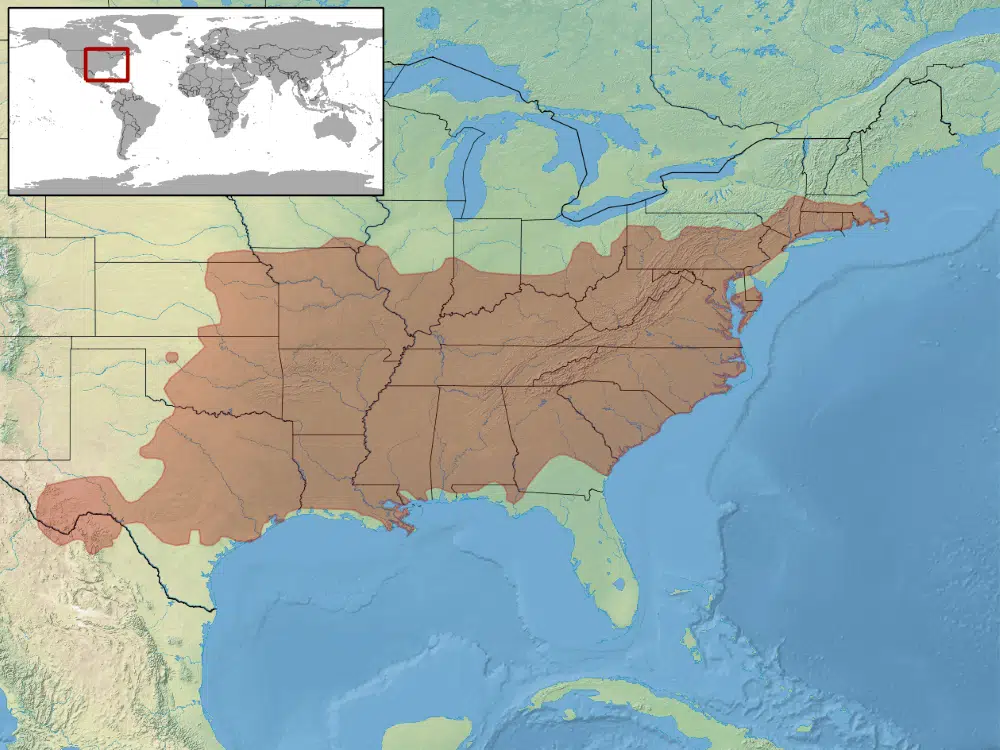
Habitat
Copperheads can be found in a variety of habitats, though they prefer to be near water. Their preferred habitat includes areas with plenty of vines, debris, and vegetation, where their color and pattern help them camouflage between dead leaves.
It is not uncommon to find copperhead snakes in undeveloped areas near suburban developments.
Size
An adult copperhead can grow to an average size of two to three feet, though they are known to grow to four feet. Females are longer than males.
Hourglass Pattern
The copperhead snake is the only snake with an hourglass pattern, which lays almost sideways on the snake’s back. The wider part of the hourglass is on one side, thinning towards the middle of the back and widening on the opposite side again.
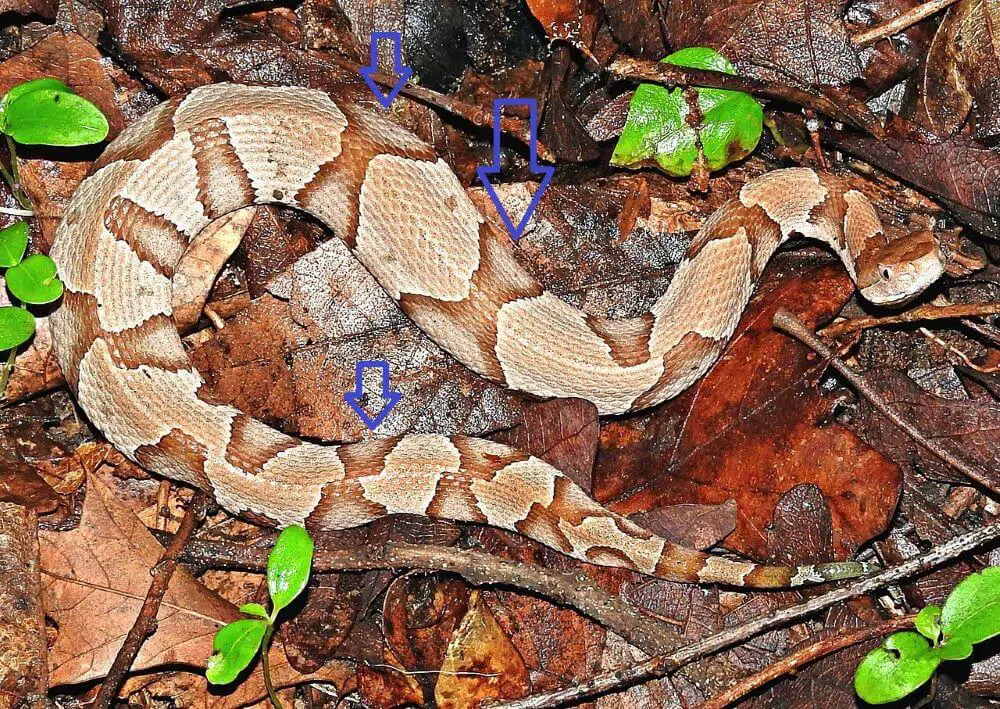
Head
The head is distinctive and triangular in shape, though some refer to it as an arrowhead. The wider part of the head makes space for the venom glands and fangs.
As the name suggests, the snake’s head is coppery reddish-brown in color with a few spots on top.
Tail-tip Color
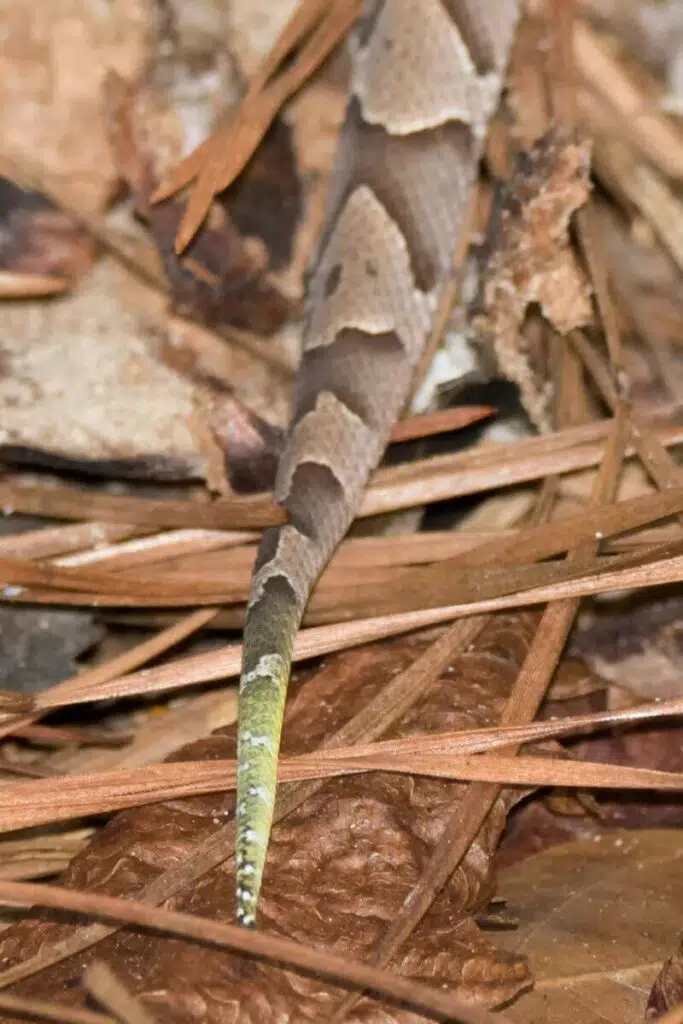
Juveniles have a bright green or yellow tip of their tail, which is used to lure frogs and lizards. This bright color fades as they age. From birth, the copperhead has functional venom glands, but it is unable to control the amount of venom injected.
Do not approach a juvenile copperhead, it can be more dangerous than being bitten by an adult.
Heat-sensing Pit
Pit vipers, which include the copperhead, have heating sensing pits on either side of the face, which is located between the eye and nostril. This helps them detect prey and ensure an accurate strike.
Eyes
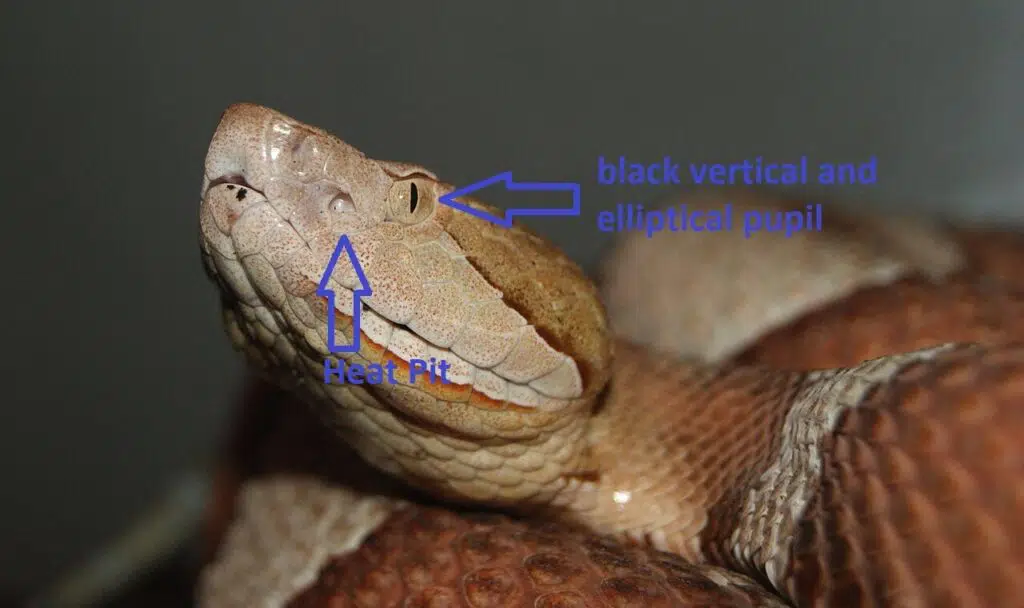
Copperheads have eyes similar to cat’s eyes with a yellow eye and black vertical and elliptical pupil. Most other snakes have round pupils, which is one of the ways you can identify a copperhead from the lookalikes.
Keeled scales
Keeled scales have a ridge down the center, that may extend to the tip of the scale, rather than being completely smooth. This makes keeled snakes, such as the copperhead, rough to touch.
The keeled scales help them move through vegetation, which gets hooked and helps the snake move around with ease.
Post-vent Scutes
The copper head has what is known as a post vent scute, which is a single, straight, and log scale that lines the belly, while all non-venomous snakes have a double-jointed scale with a zipper-shaped scute on the belly. You would have to view the snake from the underside to determine this, which is not recommended.
Snakes That Look Like Copperheads
The thirteen snakes that are often misidentified as copperheads include:
1. Cottonmouth
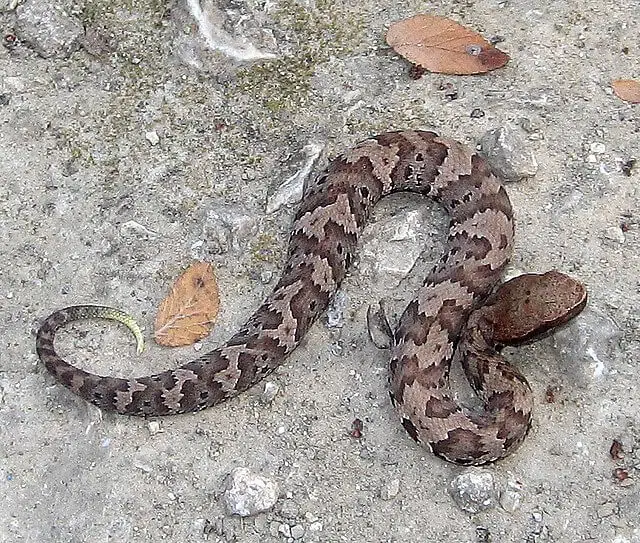
Scientific name: Agkistrodon piscivorus.
Common name: cottonmouth, water moccasin, swamp moccasin, black moccasin, viper.
The cottonmouth is another venomous snake, closely related to the Copperhead and they look similar if you only get a quick glance at the snake, which is why they are often confused with one another.
Cottonmouths have a white mouth and are black to dark brown, they are so dark their pattern is barely visible. While their hard-to-see pattern does look like an hourglass, it is messy with blurred lines and other shapes added in between.
They grow to an average of 48 inches (122cm) and are heavy-bodied.
Cottonmouths prefer wet and swamp areas, though they do migrate when their swamps begin to dry, reappearing when there is rain.
Cottonmouth vs Copperhead
- Cottonmouths are larger than the copperhead
- The cottonmouth has a white mouth
- They are black to dark brown with a barely visible pattern
- The pattern is a messy hourglass with blurred lines, while the copperheads hourglass is distinct and clear
2. Corn Snake
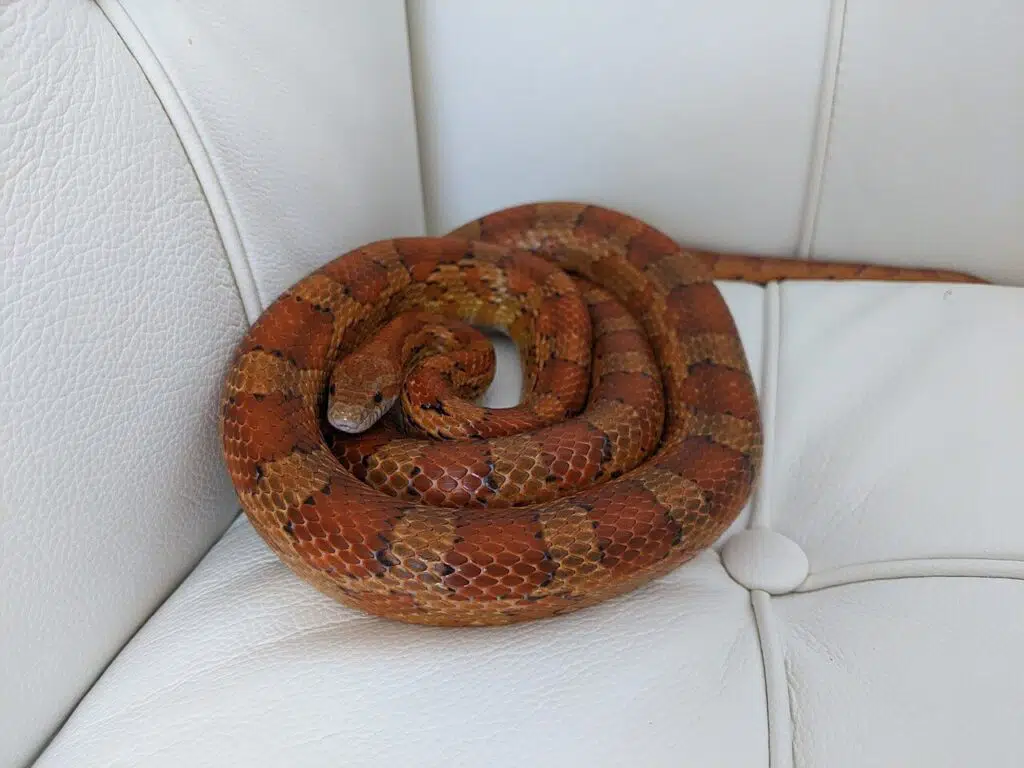
Scientific name: Pantherophis guttatus.
Common name: corn snake.
Corn snakes are harmless snakes that come in a range of colors from brown and gray to red or orange. They have a spear-shaped head and a slender body. They have tiny teeth and are unlikely to bite. They can grow up to six feet in length and weigh up to 900 grams.
Corn Snake vs Copperhead
- Copperheads grow up to four feet, corn snakes grow up to six feet
- The corn snake has a spear-shaped head, smaller than that of the triangular head of the copperhead
- The corn snake can vary in color from brown, gray, red, or orange
- The corn snake is a slender snake, where the copperhead is a bulkier snake
- The corn snake does not have an hourglass pattern on its body
3. Northern Water Snake
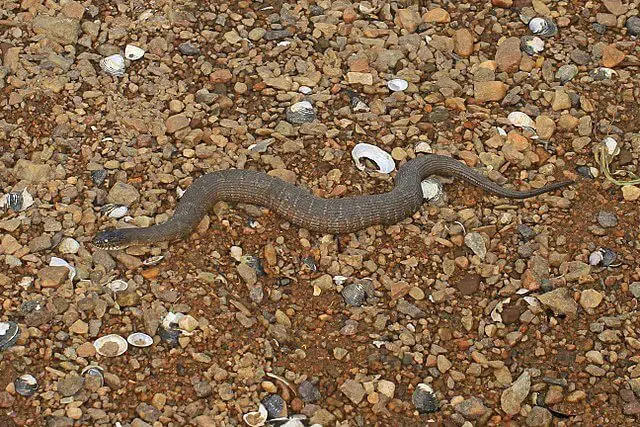
Scientific name: Nerodia sipedon.
Common name: banded water snake, black water adder, black water snake, brown water snake, common water snake, common northern water snake, eastern water snake, North American water snake, northern banded water snake, northern water snake, spotted water snake, streaked snake, water pilot, water snake.
Northern water snakes are non-venomous and seldom stray far from water. They are mostly encountered in swimming holes, waterfalls, streams, and lakes. They bask on rocks or hang off branches near the water during the summer months when they are most active.
They can grow up to three feet with brown to gray coloration. They get darker with age. They are protected in Georgia. They will flee in the water if they are approached.
They usually have a banded pattern, which is wider on the top. Their heads are narrow, straight and slightly rounded.
North Water Snake vs Copperhead
- North water snakes grow to up to three feet, smaller than the copperhead
- They are brown to gray in color, where the copperhead tens to be more copper and red
- The north water snake will flee in water if approached, where the copperhead is more likely to stand its ground. While the copperhead is an excellent swimmer, it only swims on top of the water with its head above the surface
- The north water snakes pattern is wider on top and narrower on the sides, the copperheads hourglass pattern is wider on the sides and narrower on the top.
4. Eastern Hognose Snake
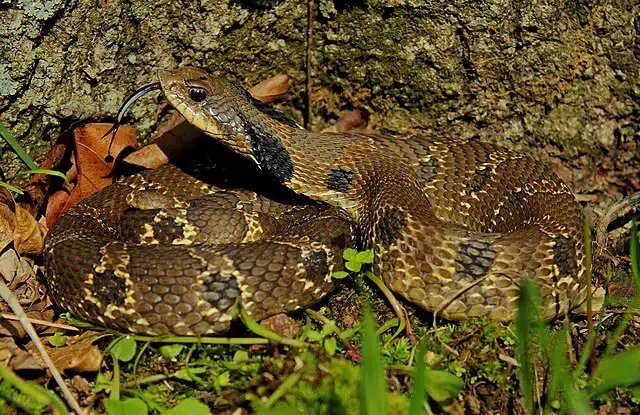
Scientific name: Heterodon platirhinos.
Common name: eastern hog-nosed snake, spreading adder, deaf adder.
Eastern hognose snakes can be found in Eastern North America. They are common in Minnesota, Wisconsin to southern Floria and Texas
These non-venomous snakes try and make themselves look like a cobra when threatened, giving their heads a triangular appearance.
They can grow up to 46 inches (116cm) in length with a varying color pattern. They can be orange, green, brown, gray, black or red, or a combination of colors. Some have checkered markings, some have blotches and many don’t have any pattern.
Their belly is gray, yellow, or cream with the underside of the tail being lighter than the belly.
Eastern Hognose vs Copperhead
- The Eastern hognose coloration can vary and be mixed with or without a pattern, while the copperhead has a distinct hourglass pattern.
- The Eastern hognose belly is gray, yellow, or cream, while the copperheads are white or yellow.
- The Eastern hognose has round eyes, while the copperhead has cats eyes
5. Texas Brown snake
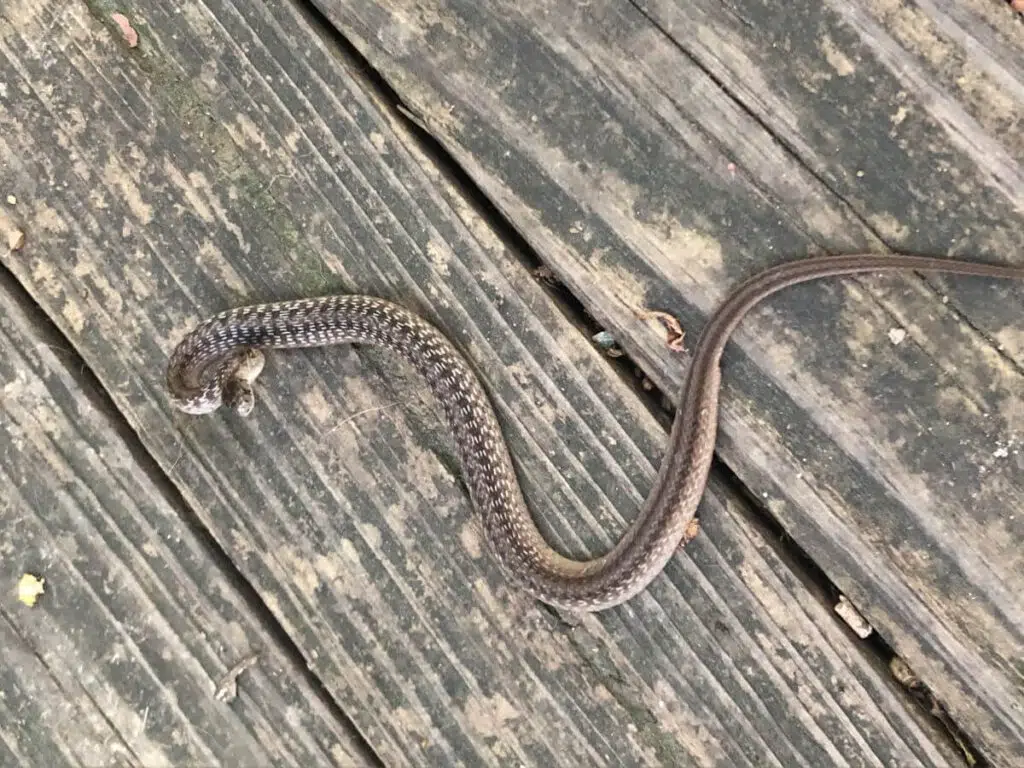
Scientific name: Storeria dekayi texana.
Common name: Texas brown snake.
The Texas brown snake is a small and slender snake that is brown to a red/brown or gray in color. It has two parallel rows of dark spots which border a lighter stripe, which runs down their back.
They grow to an average of 21 inches (53cm).
These snakes do well in residential areas and are not uncommon visitors to urban areas, where they hide under construction materials and trash piles. They also take up habitat in forests and marshes.
Texas Brown Snake vs Copperhead
- Texas brown snake is slender and small, where the copperhead is medium and bulky
- The Texas brown snake has a light stripe down the center of the back with dark spots, the copperhead has a distinct hourglass pattern.
- The Texas brown snake is smaller than the copperhead, measuring up to 21 inches.
- The Texas brown snake is a common visitor in urban areas
6. Mole Kingsnake
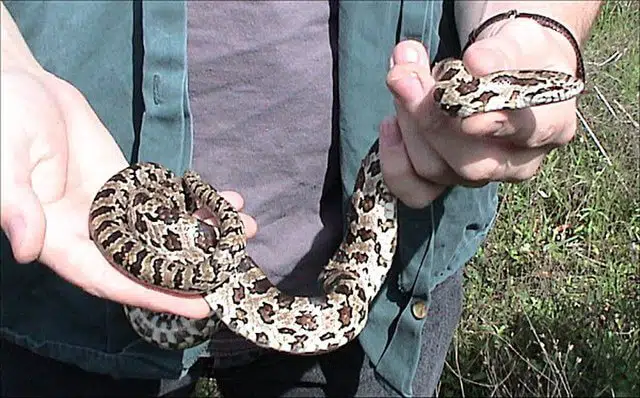
Scientific name: Lampropeltis calligaster rhombomaculata.
Common name: mole kingsnake, brown kingsnake.
Mole kingsnakes have a pattern that fades with age. As they age, they turn a uniform brown color, though some do hold onto their pattern throughout their lives. These snakes are red to brown to color with small oval spots on their backs with narrow heads and small dark eyes.
They can grow up to 102cm in length and are not considered a medical emergency if you do experience a bite.
Mole Kingsnake vs Copperhead
- Moles kingsnakes pattern fades with age, while copperheads hold onto their hourglass pattern throughout their lives
- Mole kingsnakes are a red to brown color, while copperheads are a rusty brown
- The pattern of the mole kingsnake is oval spots on the back only, while the copperhead has an hourglass that runs from one side to the other
- The mole kingsnake has small dark eyes, while the copperhead has large yellow eyes
- The mole kingsnake has a narrow head, compared to the large triangular-shaped head of the copperhead
7. Eastern Milk Snake
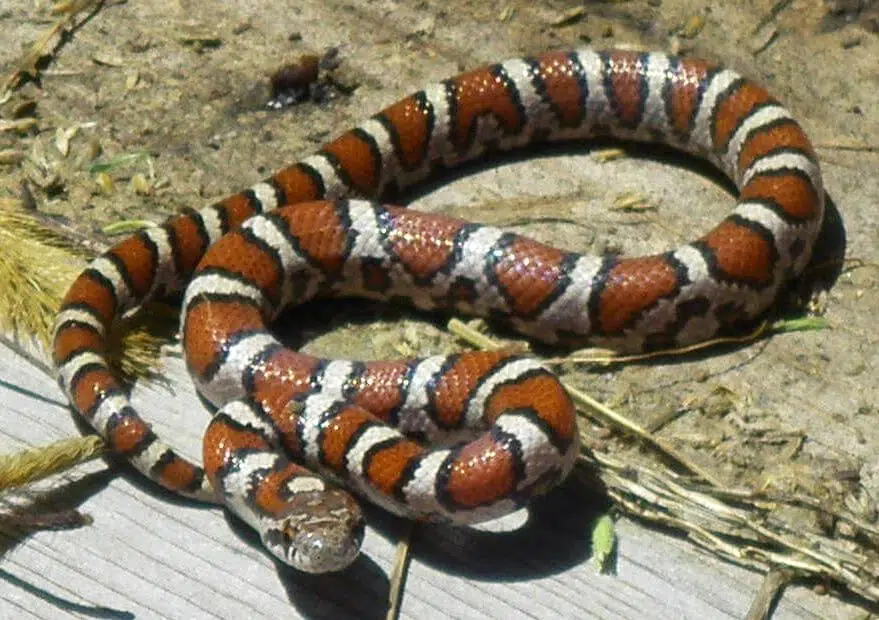
Scientific name: Lampropeltis triangulum triangulum.
Common name: Eastern milk snake.
Eastern milk snakes can be found from Maine to Ontario. These snakes grow to 36 inches (91cm) in length with smooth, shiny scales.
They have brown dorsal saddles, edged in black. The body is tan to gray. They have five blotches along their length. Their belly is a black and white checkered pattern.
These are docile and non-venomous, very popular pets with exotic pet owners. It’s not uncommon to confuse the eastern milk snake with a copperhead due to its similar pattern.
Eastern Milk Snake vs Copperhead
- Eastern milk snakes are docile, while copperheads will strike at anything and for any reason
- The Eastern milk snakes pattern is more intense than that of the copperhead with more red and the pattern clearly outlined in black
- Eastern milk snakes are smaller than the copperhead
- Copperheads have keeled scales, the Eastern milk snake has smooth and shiny scales
8. Eastern Rat Snake
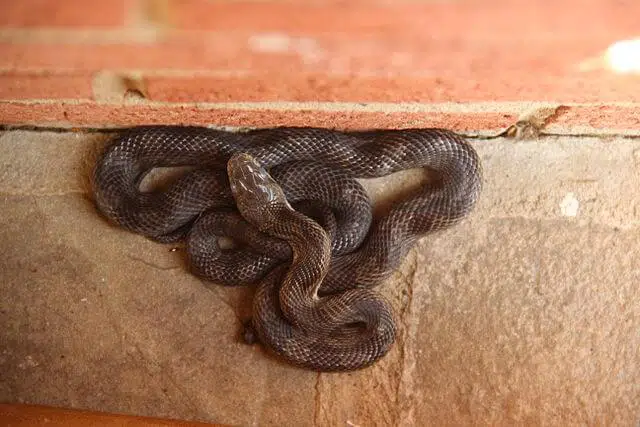
Scientific name: Pantherophis alleghaniensis.
Common name: Eastern rat snake.
Eastern rat snakes are common east of the Apalachicola River in Florida to Georgia, New York, Vermont, Maryland, Pennsylvania, South, and North Carolina.
These snakes grow to 72 inches (180cm) in length and are shiny in color with a cream or white throat and chin. They have a black and white checker pattern on their belly, turning gray closer to the tail. Their scales are weakly keeled.
The Eastern rat snake can be found in a range of habitats from hardwood forests and wetlands to urban woodlots, farmlands, and back yards. They are known to live in attics undetected.
Eastern Rat Snake vs Copperhead
- Eastern rat snakes are longer than the copperhead, growing up to six feet in length
- the Eastern rat snake is shiny with a white throat and chin
- They have a checkered pattern on their belly, where the copperhead is uniform white or yellow.
- The Eastern rat snake has weakly keeled scales, while the copperhead has keeled scales
- The juvenile Eastern rat snake is misidentified due to the brown and gray patches it has after birth, which fades with age.
- Eastern rat snakes are known to move into attics and basements during winter, copperheads will not look for shelter in a human home.
9. Western Rat Snake
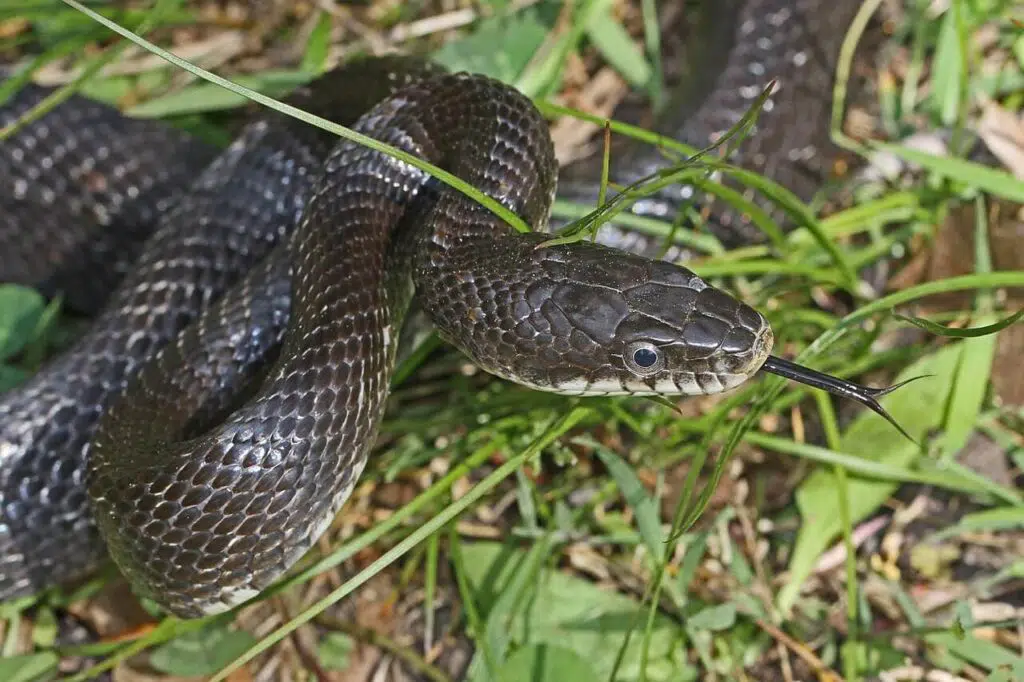
Scientific name: Pantherophis obsoletus.
Common name: western rat snake, black rat snake, pilot black snake, black snake.
Western rat snakes are common west of the Mississippi River, through to Iowa, Missouri, and Arkansas to Louisiana, Texas, Kansas, Oklahoma, and Nebraska.
They can vary in color with most being brown with a black pattern on their backs.
They can live in a range of habitats and are excellent climbers, often found in trees, farmlands, and rocky hillsides. They prefer wooded areas and are competent swimmers.
They are large snakes and grow to six feet in length, weighing up to 2.2 kilograms. Juveniles are patterned with brown patches on a gray background, which darkens with age. Adults are glossy black with white throat, lips, and chin.
They are non-venomous and not considered harmful to humans. These snakes tend to flee when approached.
Western Rat Snake vs Copperhead
- Western rat snakes are black with copperheads being sandy to rusty brown
- The rat snake has a small head compared to the large triangular head of the copperhead
- There are no fangs in the Western rat snake
- The Western rat snake has a large cluster of scales just above the eye, while the copperhead has a small cluster of shiny scales above the eye
10. Diamondback Water Snake
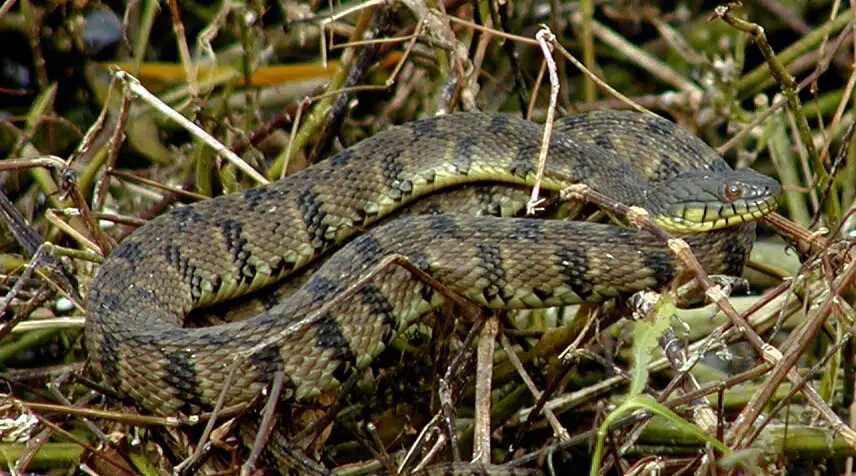
Scientific name: Nerodia rhombifer.
Common name: Diamondback water snake.
Diamondback water snakes are brown, olive green, or dark brown with a black net-like pattern on their backs. The spots resemble diamonds with bars and light colors on the sides.
They are yellow to light brown on their belly with black patches. They have keeled scales and can grow to 48 inches (122cm) in length. They are light in color with pronounced patterns which fade with age.
They are common near streams, rivers, ponds, and swamps.
Diamondback Water Snake vs Copperhead
- Diamondback water snakes can be brown, dark brown, or olive green, where copperheads remain a rusty to sandy brown color
- The diamondback water snake has a diamond-shaped pattern on its back, unlike the hourglass pattern of the copperhead
- The belly also varies with copperheads having a solid yellow or white belly, while the diamondback water snake has a light brown to yellow belly with black patches
11. Banded Water Snake
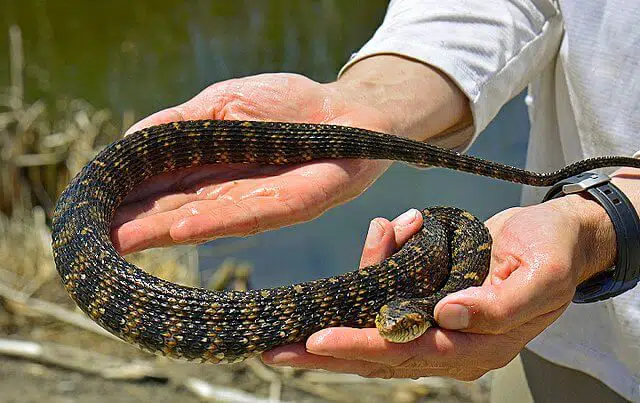
Scientific name: Nerodia fasciata.
Common name: banded water snake, southern water snake.
Banded water snakes are non-venomous fish-eating snakes that hunt along water’s edges. They eat crayfish and salamanders, swimming in fresh and brackish water.
Many banded water snakes are killed each year after being confused for a copperhead.
The banded water snakes’ banding is wider than the copperhead, going all the way across the body. These snakes grow to 48 inches (106cm) and are heavy-bodied, they are also semi-aquatic. They have rounded heads with a shiny cap of scales covering their head.
Banded Water Snake vs Copperhead
- Banded water snakes are smaller than the copperhead
- They have a rounded head, rather than the triangular shape of the venomous copperhead
- They have smooth shiny scales covering most of the head, where the copperhead only has small and shiny scales between the eyes
- The banded water snake does not have heat-sensing pits between the eyes and nostrils
- Banded water snakes have banding that is wider than the copperhead and is the same around the body
12. Eastern Racer
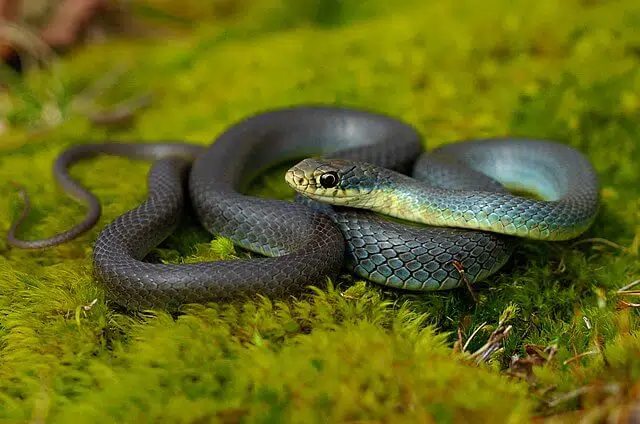
Scientific name: Coluber constrictor.
Common name: Eastern racer.
Eastern racers are distributed throughout the United States, east of the Rocky Mountains, and are non-venomous snakes that can grow to five feet in length.
Adults are black with no pattern, but juveniles tend to have a different pattern with red/brown markings on their backs, which makes them look similar to the venomous copperhead. Juveniles have black patches of thick circles on the back and nothing on the sides.
Eastern Racer vs Copperhead
- Adult Eastern racers are black when adults, where copperheads always have an hourglass pattern
- Juveniles have a red/brown pattern on their backs, but not on their sides. The copperheads pattern is distinguished as an hourglass which is wider o the sides and thinner in the center of the back
- Eastern racers have rounded heads with black eyes, while copperheads have triangular-shaped heads with yellow eyes
13. Brown Water Snake
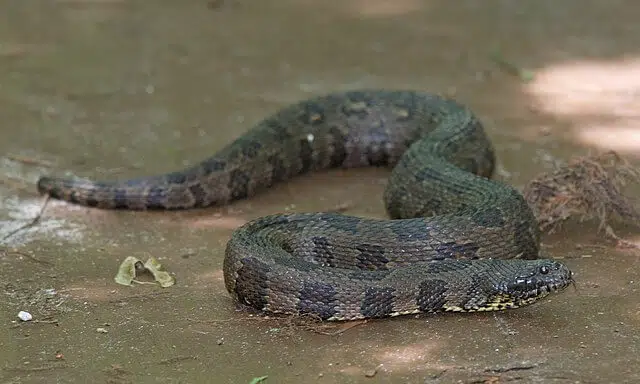
Scientific name: Nerodia taxispilota.
Common name: Brown water snake.
Brown water snakes are large and heavy-bodied snakes with a neck that is narrower than the head. They are brown to a rusty brown color with black or dark brown square patches down the back. There are smaller patches alternating on either side. They have a yellow belly with ark brown to black patches.
They can grow to sixty inches and prefer swamps and streams to forests.
Brown Water Snake vs Copperhead
- Brown water snakes necks are narrower than the rounded head, where copperheads have a distinct triangular shaped head
- The brown water snake has black to dark brown square patches on the back with smaller patches alternating on the sides, where the copperhead has a distinct hourglass pattern that is wider on the sides and narrower in the middle
Copperhead Bite
If you are accidentally bitten by a copperhead, here are some things you need to know.
Symptoms
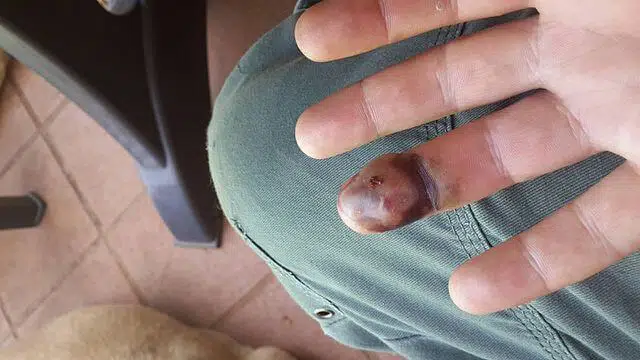
A bite from a copperhead can offer a range of unwelcome symptoms which may start within minutes to hours after being bitten. Some of the most common symptoms of a copperhead bite include:
- Immediate pain with rapid swelling
- Bruising at the bite site
- Problems breathing
- Increased heartbeat
- Metallic taste in the mouth
- Numbness around mouth, tongue, feet, and the bite area
- Lymph node swelling near the bite area
- Signs of being in shock
Treatment
Do you know what you should and should not do if you or someone you know is bitten by a copperhead? Here are some things you should do when dealing with a copperhead bite:
- Take note of the color and shape of the snake to ensure it can be identified as a copperhead
- Remain calm and still. Getting worried and anxious will increase the heart rate, causing the venom to move throughout the body faster
- Seek immediate medical attention, call 911 or go to your local emergency room
- If you cannot get to a hospital immediately, keep the person calm, keep the bite below the level of the heart, wash the wound in warm soapy water and cover it with a dry dressing.
There are also some things you must never do if you or someone you know is bitten by a copperhead. Things you should not do includes:
- Trying to capture or pick up the snake
- Do not apply a tourniquet
- Do not suck out the venom or cut the wound with a knife
- Do not apply ice or put the bite area in water
- Do not drink any alcohol
- Do not have any caffeinated beverages until you have the medical attention needed
What To Do When You See A Snake
Snakes are common, often living within close proximity of humans. Do you know what to do if you see a snake? Do you know how to prevent snakes?
What to do when you see a snake
You should never try and capture or kill a snake you find in your yard or home. You should walk away slowly, keeping an eye on it from a few meters away. Keep pets and children away from the snake until it has moved along on its own. In most cases, a snake in the home or yard is simply passing through.
Always leave the snake alone, try and identify it and leave it alone if it is in an outbuilding or is non-venomous. If you identify the snake as venomous, such as a copperhead, then you should take it seriously, ensuring it is removed by a professional to protect your children and pets.
How to prevent snakes
The good news is that there are a number of things you can do to prevent snakes in your home and yard, which includes:
- Clearway debris and rock piles, as snakes find them appealing hiding places
- Keep your lawn short
- Avoid unnecessary moisture by not overwatering your garden which attracts rodents, insects, amphibians, and birds, which are a tasty meal for a snake
- Move firewood away from the house, as snakes love to hide in woodpiles
- Pick up leftover pet food and fallen fruit, which can attract rodents and in turn attract snakes
- Seal any cracks in your foundation
- Eliminate pests
- Remove birdhouses
- Use aluminum flashing under fences
- Attach screens to doors and windows
- Cover drains and vents with galvanized screening
If you are seeing more and more snakes in your yard, then you may want to try some essential oils, such as clove and cinnamon, which deter snakes. Grow some unpleasant plants for snakes, such as lemongrass and garlic.
Summary
Once you know how to identify the venomous copperhead from the non-venomous lookalikes, you will be able to quickly determine which snakes to be worried about if they make their way into your yard or home.
The good news is that most snakes you encounter are non-venomous, but there are times where you may see a copperhead. Remember to move away slowly as they are always willing to strike.
Further Reading: